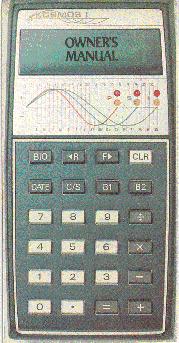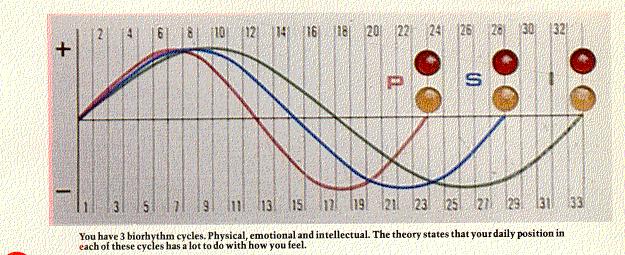 The following is taken from the KOSMOS-1 Owner's Manual.
The following is taken from the KOSMOS-1 Owner's Manual.
| [BIO] | Biorhythm |
| [DATE] | Date |
| [B1] [B2] | Birthdate |
| [C/S] | Compatibility/Similarity |
| [F>] | Forward |
| [<R] | Reverse |
Date Key:
[DATE] Enters the desired date (Month, Day, and Year).
To enter the date, for example, June 7th, 1976, operate
[0][6] [0][7] [7][6] [DATE]
After pressing the [DATE] key, the date plus the day of the week will be divisible on the display.
Birthdate Keys:
[B1] This key is for keying in your own birthdate.
[B2] This key is for keying in another persons birthdate.
After pressing the birthdate keys, the date plus the day of the week will be visible on the display.
"In addition, use of either the [B1] or [B2] keys is illustrated by a display in the extreme left hand digit. When using [B1] - a U will appear in the top half of the digit. When using [B2] - an inverted U will appear in the lower half of the digit."
Biorhythm Keys:
[BIO] When all data has been put in correctly, pressing this key
obtains the biorhythm and displays them.
Compatibility/Similarity Key:
[C/S] This key will cause the computer to calculate the compatibility
between yourself and another person and display them.
Forward/Reverse Keys:
[<R] This decrement key will cause the date to reverse each one.
Simultaneously the new biorhythm will be computed and displayed.
[F>] This increment key is identical to the [<R] key
except that it advances the date in daily increments.

Personal Biorhythm
| Step 1. | Turn the power switch [ON] |
| Step 2. |
Key in today's date (or date on which the biorhythms are to be calculated.)
Example: For June 7, 1976, press the keys in the following order:
[0][6] [0][7] [7][6]
Only the late two digits of the year are to be keyed in. Note: For
month and day two digits must be keyed in.
|
| Step 3. | Press [DATE] key. |
| Step 4. | Key in the birthdate in the same form as today's date (Step 2). |
| Step 5. | Press [B1] key. |
| Step 6. |
Press [BIO] key.
The display will now change to indicate points on the three biorhythm curves. |
Rapid Determination of Biorhythm Points Ahead or Behind Today's Date
| Step 1. | Calculate Biorhythms as above (Step 1-6). |
| Step 2. |
Press [F>] (increment) key.
Display will change to show date immediately following that initially set. |
| Step 3. |
Press [BIO] key.
Display will change to show the biorhythm points for that day.
Note: Steps 2 and 3 may be repeated as many times as desired.
|
Rapid Determination of Critical and Mini-Critical Days
| Step 1. | Calculate Biorhythms as above (Step 1-6). |
| Step 2. | Press [F>] key. Display will show new date. |
| Step 3. |
(a) If none of the traffic lights are lit, press [F>] again.
Display will show new date.
(b) If traffic lights are lit, press [BIO] key to obtain all biorhythm data for that day. Note: Steps 2 and 3 may be repeated using either [F>] or [<R] as often as required. |
At anytime the calculator is operating in the biorhythm mode, the indicator lights will give a flashing warning of critical and mini-critical days as follows.
| Critical Days (Red Light) |
Mini-Critical Days (Yellow Light) | ||||
| Physical | 1 | 12 & 13 | 7 | 18 | |
| Sensitivity | 1 | 15 | 8 | 22 | |
| Intellectual | 1 | 17 & 18 | 9 | 26 | |
Note: What this means is that depending on your hour of birth, you could begin your critical day on one day and end it on the next. This holds true especially for your physical and intellectual cycles when you're on your way to the minus phase of each.
Another Person's Biorhythm
| Step 1. | Key in today's date (or date on which the biorhythms are to be calculated.) |
| Step 2. | Press [DATE] key. |
| Step 3. | Key in person's birthdate. |
| Step 4. | Press [B2] key. |
| Step 5. |
Press [BIO] key.
The display will now change to indicate the points on this person's three biorhythm curves. |
Biorhythmic Compatibility Between Yourself and Other People
| Step 1. | Key in your own birthdate. |
| Step 2. | Press [B1] key. |
| Step 3. | Key in other birthdate. |
| Step 4. | Press [B2] key. |
| Step 5. |
Press [C/S] key.
The display will now change to show compatibility as a percentage each of the three cycles between you and the other person. |
Note:
(1) Steps 3 through 5 may be repeated for as many people as required.
(2) If your birthdate and that of any other person have already been
input, all that is required is to press [C/S] key.
Compatibility/Similarity Ratio (c/s): This simply shows how your biorhythm blends in with some else's.
People with the same birth dates have biorhythms that run in the same cycles. So they are compatible 100% of the time.
People with different birth dates have biorhythms that run in different cycles. They are compatible a lower percentage of the time.
The farther apart their cycles are, up to the half-way point of each, the less compatible they are.
Critical: On your biorhythm graph, any day of any cycle that crosses the center line of division is called a critical day. On those days you are prone to be a little less sharp than you would normally be.
Critical Line: This is the center line of division on your biorhythm graph. In each of your cycles, the days above your critical line are apt to be better than thhe days below it.
Cycle, Emotional (Sensitivity Cycle): This biorhythmic cycle is 28 days long and affects your creativity, sensitivity, and mood, as well as your perceptions of the world and yourself. Some researchers even feel that the sex of your children is affected, to some degree, by which phase of your emotional cycle they were conceived under.
Cycle, Intellectual: This cycle takes 33 days to complete. It helps regulate your memory, alertness, receptivity to knowledge and the logical and analytical functions of your mind.
Cycle, Physical: This is a 23-day cycle. It affects your strength, coordination, speed, physiology and your resistance to disease. Basically, your daily position in your physical cycle has a lot to do with whether you're full of pep. Or feel lazy.
High (plus day): On any days which appear above the critical line on your biorhythm graph, you are on what researchers call a high. On those days, you are apt to have more energy, fell more emotionally stable and be more alert.
Low (minus day): On any days which appear below the critical line, you are on a low. So, the conditions above are prone to be just the opposite.
Mini-Critical: "The mini-critical is a recent important discovery
that has been made by researchers specializing in biorhythm studies.
It seems to indicate that at the mid-point between two critical days
individuals, especially athletes, seem to be less coordinated than on
critical days which have long been looked at by scientists to prove the
validity of biorhythm, as well as the explanation of why certain
individuals behave irrationally during these biorhythmic peaks and
valleys, and sometimes at a time when biorhythmically they should be
at their highest point."
Bernard Gittelson
Click here for the home page.
Click here for the calculator page.
Click here for the wanted page.
Last updated November 30, 2002